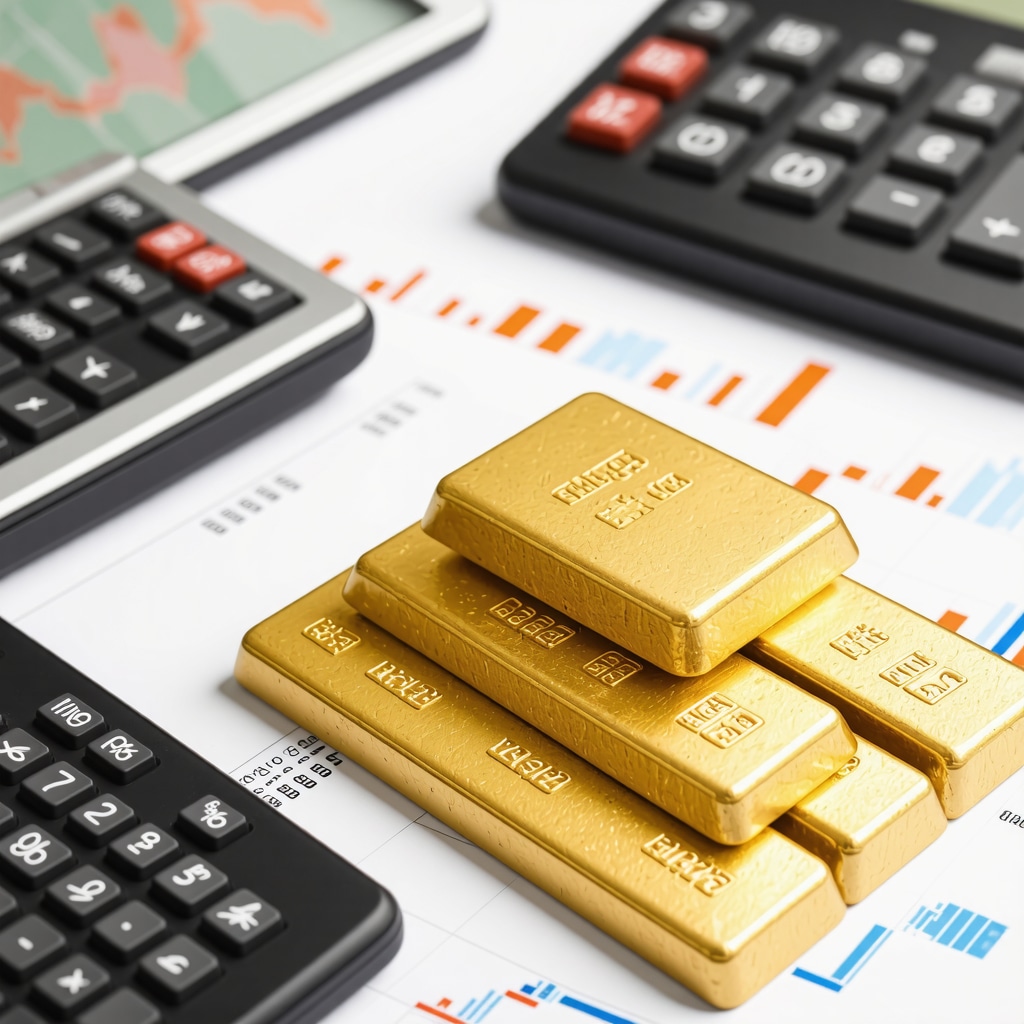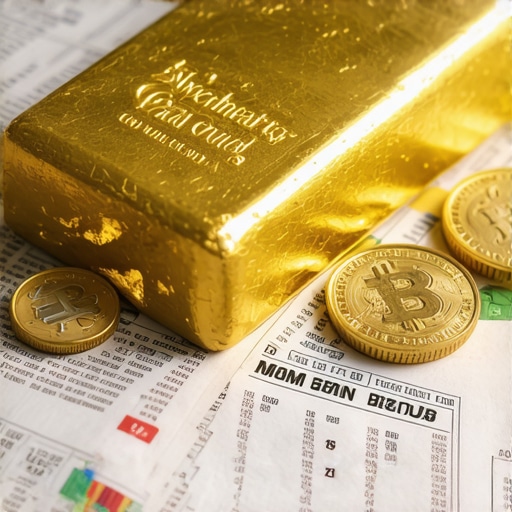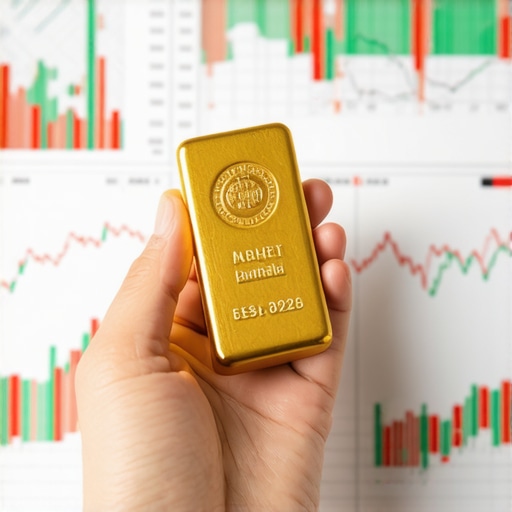How I Took My First Steps into Gold Investing
I still remember the day I decided to invest in gold. It wasn’t some grand financial plan but rather a moment of curiosity sparked by news about rising inflation and market volatility. Like many beginners, I was hesitant, unsure of how to start and what risks were involved. Over time, through trial, error, and research, I learned some essential tips about investing in gold that I’d love to share with you.
Why Gold Felt Like a Safe Haven in 2025
In my experience, gold’s timeless appeal lies in its ability to hedge against economic uncertainty. In 2025, with fluctuating markets and inflation concerns, I found gold to be a reliable asset to balance my portfolio. It’s not just about owning a shiny metal; it’s about understanding how gold acts as a shield against unpredictable financial storms. The World Gold Council highlights this role, noting that gold retains value even when traditional markets dip, which cemented my trust in this precious metal.
What Should Beginners Know Before Buying Their First Gold Investment?
One of the most frequent questions I get is: “Where do I start?” For me, the first step was deciding the type of gold investment that suited my goals. Physical gold like bars and coins offers tangible ownership, but it requires secure storage and verification of authenticity. On the other hand, gold stocks, ETFs, and mutual funds provide easier liquidity and diversification but come with different risk profiles. For beginners, I recommend reading guides such as common pitfalls to avoid when investing in gold, which helped me steer clear of rookie mistakes.
Lessons Learned: Balancing Physical Gold and Gold Stocks
Personally, I found a blend of physical gold and gold stocks works best. Initially, I bought a few gold coins following a step-by-step guide on buying gold coins safely. This gave me the confidence of holding a tangible asset. Later, I ventured into gold mining stocks and ETFs, which I managed by understanding the risks and rewards highlighted in trusted resources like gold mining stocks risks and rewards. This diversification helped me navigate market volatility more comfortably.
Why Staying Informed Made All the Difference
Investing in gold is not a “set it and forget it” deal. I regularly follow market trends and expert forecasts, such as those provided by gold price forecasts for 2025. Understanding supply and demand dynamics, along with central bank gold purchases, gave me a clearer picture of price movements. This ongoing education was crucial in making smarter investment decisions and adjusting my strategy as the market evolved.
If you’ve started investing in gold or are considering it, I’d love to hear about your experiences or questions. Feel free to share in the comments below — your story might help someone else take that confident first step!
Deepening Your Gold Investment Strategy: Navigating Market Complexities
As I progressed in my gold investment journey, I realized that a nuanced approach is essential. Beyond just owning gold bars or stocks, understanding the interplay of global economic factors, geopolitical tensions, and monetary policies became crucial. These elements influence gold prices significantly, so keeping an eye on them helps in timing purchases or sales strategically.
For instance, central bank gold purchases have a profound impact on the market. In recent years, many central banks have increased their gold reserves, signaling confidence in gold as a safe asset amidst currency fluctuations. This trend tends to tighten supply and elevate prices, presenting opportunities and risks for investors alike. Resources like how central bank gold purchases affect market dynamics offer detailed analyses that I found instrumental in anticipating price shifts.
How Can Investors Balance Gold’s Role as a Hedge with Its Market Volatility?
Gold is often praised as a hedge against inflation and market downturns, yet it’s not immune to price swings. As an investor, I learned that balancing gold’s protective qualities with its inherent volatility requires a disciplined strategy. Diversifying within gold investments — combining physical gold, mining stocks, ETFs, and mutual funds — spreads risk across different asset behaviors.
Moreover, setting clear investment goals and time horizons helps mitigate panic during dips. For example, physical gold generally serves long-term preservation, while gold stocks might offer growth potential but with higher short-term fluctuations. Following expert insights from financial authorities like the Investopedia gold investing guide deepened my understanding of these dynamics and informed my portfolio adjustments.
Integrating Gold Investments into a Broader Portfolio Strategy
One vital lesson I learned is that gold should complement, not replace, other asset classes. Its role as a portfolio diversifier can reduce overall risk, especially during economic uncertainty. I explored various allocation models, often dedicating 5-15% of my portfolio to gold-related assets, which aligned with my risk tolerance and financial goals.
Additionally, tracking global gold demand trends — including jewelry, technology, and central bank activity — offers clues about future price movements. Keeping informed through analysis of global gold demand trends helped me anticipate shifts and manage my investments proactively.
If you’ve found this deeper dive helpful, please consider sharing this article or leaving a comment with your own strategies. Your insights can enrich this community of gold investors and help others make informed decisions.
The Subtle Art of Timing: When to Buy and When to Hold
One of the trickiest lessons I’ve learned is that gold investing isn’t just about owning the metal or shares—it’s also about timing. Early on, I found myself wondering if I should buy during price dips or wait for a clearer market signal. What really helped was tracking macroeconomic indicators and central bank activities, which often foreshadow shifts in gold prices. For example, understanding how central bank gold purchases drive market movements gave me a framework to anticipate when demand might surge, tightening supply and pushing prices upward.
Patience became a key virtue. Rather than chasing quick gains, I learned to align my purchase decisions with broader economic trends. This approach reduced the emotional rollercoaster and helped me maintain a balanced portfolio.
Is It Better to Focus on Physical Gold or Gold-Backed Securities?
This question came up often in my conversations with fellow investors. My experience suggests there’s no one-size-fits-all answer. Physical gold offers a comforting tangibility, but it requires secure storage and can involve premiums over spot prices. Meanwhile, gold stocks and ETFs provide liquidity and diversification but expose you to market and company-specific risks.
Personally, I found that combining both types—guided by resources like the beginner’s guide to gold stocks and the best practices for physical gold investments—helped me capture the benefits of each. This blend also hedged against the distinct risks inherent in each asset type.
Reflecting on Market Sentiment: The Emotional Undercurrents of Gold Investing
Gold’s price movements aren’t dictated solely by tangible factors like supply and demand; they’re also shaped by investor psychology and global sentiment. I recall moments when geopolitical tensions spiked, causing a sharp rush toward gold—almost as if investors collectively sought refuge in its stability. These waves of sentiment can create both opportunity and volatility.
Learning to read these emotional currents, alongside technical and fundamental analysis, was crucial. Tools like market trend analysis for 2025 helped me contextualize these shifts rather than react impulsively.
Understanding this interplay deepened my appreciation for gold not just as an investment, but as a barometer of global economic confidence and anxiety.
If you’ve noticed how market mood swings influence your gold investments, I’d love to hear your stories or insights. Sharing these experiences can be a powerful way to learn and grow together.
When to Rebalance: Gold’s Role in an Evolving Portfolio
Over time, I realized that my gold allocation wasn’t static. Life changes, market conditions, and financial goals shift, requiring periodic reassessment. I began scheduling regular portfolio reviews, considering factors like inflation trends, currency movements, and my personal risk tolerance.
This dynamic approach aligns with strategies discussed in pieces like best gold investment strategies to hedge inflation. It taught me that gold isn’t just a set-it-and-forget-it asset but a living component of a well-rounded financial plan.
Adjusting my gold holdings thoughtfully, whether by adding during dips or trimming to rebalance risk, helped me stay resilient in volatile markets.
How Can Investors Stay Ahead of Gold Market Volatility Without Losing Sleep?
For many, the volatility of gold prices can be nerve-wracking. My personal approach centers on education and preparation. Following expert analyses like gold price forecasts for 2025 allows me to anticipate potential fluctuations rather than be blindsided.
Additionally, I focus on diversification—not just within gold but across my entire portfolio—which cushions against unexpected swings. Setting clear investment goals and time horizons also provides a mental anchor during turbulent times.
Ultimately, embracing volatility as part of the investment landscape, rather than fearing it, made a significant difference in my confidence and decision-making.
Embracing Complexity: How Macroeconomic Nuances Shape My Gold Investment Decisions
As I delved deeper into gold investing, I recognized that the asset’s value is intricately intertwined with a web of macroeconomic factors beyond mere supply and demand. Factors such as currency devaluations, interest rate shifts, and geopolitical turmoil create a dynamic environment where gold often emerges as a sanctuary. My personal approach evolved to integrate these complex indicators, enabling me to anticipate market inflection points rather than react to them. For example, monitoring central bank gold purchases—highlighted extensively in how central bank gold purchases affect market dynamics—proved indispensable. These institutions’ actions often presage tightening supply and price surges, allowing me to position my portfolio proactively.
Beyond conventional metrics, I started paying close attention to the subtle shifts in global trust toward fiat currencies, which often precipitate increased gold demand. This multi-dimensional analysis has been pivotal in navigating the choppy waters of 2025’s volatile markets.
How Do I Navigate Emotional Biases While Managing Gold’s Volatility?
One of the most challenging aspects of gold investing is managing the emotional undercurrents that price volatility can provoke. Gold’s allure often triggers impulsive buying during geopolitical crises or panic selling when prices dip unexpectedly. Over time, I cultivated a disciplined mindset through structured portfolio reviews and reliance on data-driven insights rather than hearsay or sentiment-driven impulses. Utilizing comprehensive resources like market trend analysis for 2025 helped me contextualize price swings within broader economic narratives, reducing emotional reactivity.
My strategy evolved to include setting predefined thresholds for buying or trimming gold holdings, which helped me avoid the pitfalls of market timing and emotional decision-making. This emotional intelligence in investing allowed me to remain steadfast and capitalize on long-term trends rather than short-term noise.
Integrating Gold into a Holistic Wealth Framework: Beyond Asset Allocation
Gold’s function transcends mere diversification; it serves as a strategic asset class that interacts dynamically with equities, bonds, and alternative investments. I found that a holistic wealth management approach, where gold complements growth-oriented assets while providing inflation protection, yields a robust portfolio architecture. By studying various allocation models—including those that recommend a 5-15% gold weighting—I tailored my exposure to reflect both my risk appetite and evolving market conditions.
Moreover, I actively monitor global demand trends across sectors such as technology and jewelry, which influence gold’s fundamental value. Leveraging insights from analysis of global gold demand trends, I adjust my strategy to align with emerging patterns that could affect prices. This proactive stance ensures my investments remain relevant and resilient amid shifting economic landscapes.
For fellow investors seeking to deepen their understanding, engaging with these advanced facets of gold investing can transform your portfolio from a static holding into a dynamic wealth-building instrument.
If you’ve gained new perspectives from my journey or have nuanced strategies of your own, I encourage you to share your experiences in the comments below. Let’s cultivate a community where sophisticated gold investment wisdom thrives.
Things I Wish I Knew Earlier (or You Might Find Surprising)
The Emotional Rollercoaster Is Real — But Manageable
In my early days investing in gold, I underestimated how much emotions could sway my decisions. The price swings can feel like a wild ride, especially during geopolitical tensions or sudden market dips. What helped me was learning to pause and reflect rather than react impulsively. Setting clear goals and thresholds for buying or selling made the volatility less intimidating and more manageable.
Not All Gold Is Created Equal
I assumed that owning any form of gold was equally beneficial, but soon realized that physical gold and gold-backed securities each have unique benefits and challenges. For example, physical gold offers tangible security but demands safe storage, while gold stocks and ETFs provide liquidity but come with market risks. Balancing these helped me build a more resilient portfolio.
Timing Isn’t Everything — But It Matters
Chasing the perfect moment to buy or sell gold felt like a strategy at first, but I learned that timing without context can be misleading. Instead, I focused on understanding broader economic trends, such as central bank gold purchases and inflation signals, which gave me a clearer framework to make informed decisions. Patience and perspective trumped frantic timing efforts.
Gold Is More Than Just a Hedge
While I initially viewed gold mainly as a protection against inflation or market downturns, it became clear that gold also serves as a barometer of global confidence and economic shifts. Observing how sentiment and macroeconomic factors influence gold prices added a richer layer to my investment approach, making it more thoughtful and strategic.
Continuous Learning Is Key
Gold investing isn’t a “set-it-and-forget-it” endeavor. Staying informed about market trends, global demand, and geopolitical developments has been invaluable. The more I learn, the more confident and adaptable I feel, which ultimately strengthens my investment outcomes.
Resources I’ve Come to Trust Over Time
Buying Gold Now — This site has been a consistent go-to for practical guides and up-to-date analyses. Their common pitfalls to avoid when investing in gold was especially helpful during my early stages.
Investopedia’s Gold Investing Guide — For a clear and trustworthy overview of gold’s role in portfolios, this resource breaks down complex concepts in a friendly way that I often recommend to friends.
World Gold Council Insights — Their research on gold demand trends and central bank activities offers essential context that deepened my understanding of market drivers. For instance, their analyses complement articles like global gold demand trends.
Gold Price Forecasts 2025 — Following expert price predictions and market analysis through platforms like gold price forecasts for 2025 helped me anticipate shifts and plan my moves strategically.
Step-by-Step Guides on Buying Physical Gold — Practical advice on safe purchasing and storage, such as buying gold coins safely, gave me confidence to enter the physical gold market without fear.
Parting Thoughts from My Perspective
Reflecting on my journey, investing in gold has been both a learning experience and a strategic pillar in my portfolio. The keyword here is balance — balancing physical gold with securities, timing with patience, and emotions with data. Gold isn’t a magic bullet, but when integrated thoughtfully, it can provide stability and growth potential amid economic uncertainty.
If you’re considering your first gold investment or looking to refine your strategy, remember that knowledge, patience, and a well-rounded approach are your best allies. I hope my reflections and trusted resources offer a helpful starting point or new perspective.
If this resonated with you, I’d love to hear your thoughts or experiences. Feel free to drop your stories or questions in the comments below — sharing our journeys makes us all stronger investors.











Reading through the post really resonated with me, especially the emphasis on diversification between physical gold and gold stocks. When I first started investing in gold a couple of years ago, I was mostly focused on physical gold because I liked the idea of holding a tangible asset. However, I soon realized that blending in gold ETFs and mining stocks gave my portfolio more flexibility and resilience during volatile periods. One thing I’ve found challenging is accurately timing my entries and exits, especially with gold’s market being influenced by macroeconomic factors like central bank activities. The post’s point about monitoring central bank gold purchases and global demand trends is spot on, as those indicators sometimes give early signals. For those just starting out, would you recommend focusing more on physical gold for safety or diversifying early through securities to capture growth, even if it involves higher risk? I’d love to hear other investors’ experiences with balancing these approaches.
I can definitely relate to the initial hesitation that many beginners face when considering gold investments. My first step was also through physical gold, mainly because of its tangibility and the sense of security it offers. However, I found that diversifying into ETFs and mining stocks gave me better liquidity and exposure to growth opportunities, especially during volatile market conditions, much like the author described. It’s interesting how the dynamics of central bank gold purchases and geopolitical tensions influence gold prices significantly. Balancing physical gold with securities seems to provide the best hedge against uncertainty while allowing for growth when market conditions are favorable. I wonder, though, how others approach the allocation percentages between physical gold and stocks—what’s been your experience in balancing these? Do you prefer a set percentage or adjust based on market signals? Continuous learning and flexibility seem essential for navigating gold’s complex market behavior, and I’d love to hear more about different strategies that have worked for seasoned investors.